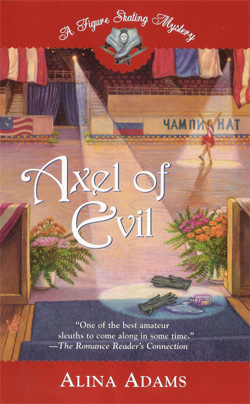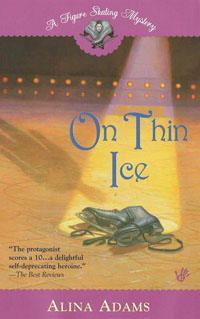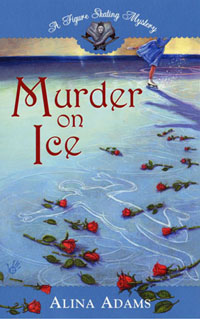AS THE WORLD "TOURS" (PART #1)
As Stars on Ice and Champions on Ice gear up for their traditional, post-Olympic season tours, www.FigureSkatingMystery.com takes a look back at the history of traveling "Ice-travaganzas...."
Before skating became a television staple, fans hoping for a glimpse of their favorite athlete outside of the national or World championship, had to wait for a touring show to come to their town.
Ice Capades, Ice Follies and Holiday on Ice were once the sole venue for seeing one or two Olympic-caliber skaters, as long as you were willing to sit through an interminable chorus line, and folks dressed as cartoon characters. Perfect for a family audience, not nearly as satisfying for the skating purist.
In 1969, however, a year after television etched Peggy Fleming onto the public's consciousness, promoter Tom Collins adjusted Europe's ISU tour of medal-winners from the World Championships, and brought his new version -- featuring both champions and local up-and-comers -- to North America. It's first few years out, the Collins Tour (official name pre-1997: Tour of World Figure Skating Champions) visited a scant fifteen cities in the weeks immediately following the World Championships, and paid its amateur skaters $50 a show.
By the late 70s, the tour had solidified its format of having medalists from that year's Worlds, plus a few other skaters judged particularly extraordinary, doing one number each under spotlights, in front of audiences ranging from 5,000 to 15,000 people. Little attempt was made to unify the solo exhibitions into a cohesive show format with group numbers. Although, at the last stop of the 1978 Tour in Providence, R.I., the skaters, including Rodnina & Zaitsev, East Germany's reigning World Champion Anett Potzsch and 1974 World Champion Jan Hoffman, England's Robin Cousins, and America's Charlie Tickner, without telling the show's organizers, put together an impromptu kick-line as a fitting finale.
Though only three weeks long, the tour was a great place for young, rising skaters to get a quick lesson in performing in front of a crowd looking to be entertained. 1984 & 1988 Olympic Silver Medalist Brian Orser admitted being puzzled his first year on the tour, when he would go out and perform the big tricks -- Triple Axel, Triple Lutz -- that drove the public wild in competition, and only receive polite applause, while Scott Hamilton, dressed in a chicken suit and skating to music peppered with clucks, would drive them to a standing ovation.
Brian Boitano joined the tour in 1984, after finishing 5th at the Sarajevo Olympics. By then, skaters were making roughly $150 dollars a show, a sum that would keep going up in conjunction with skating's popularity, but, it was still the maximum these athletes could pocket without risking their amateur status.
$150 x 15 shows equaled $2,250 U.S. Hardly enough to make a dent in the ordinary competitor's expenses. By 1995, however, Olympic-eligible skaters were earning $2,000 per show on a tour that had swelled to seventy-six shows in three months for the Spring Tour, plus an additional tour in the Winter (featuring virtually all pro skaters, while the eligibles compete at Nationals, Olympics, and Worlds). A decade after he first joined the redubbed Champions on Ice, the now pro Boitano earned over a million dollars for his participation.
Coming Up Next: Scott Hamilton creates Stars on Ice!
Before skating became a television staple, fans hoping for a glimpse of their favorite athlete outside of the national or World championship, had to wait for a touring show to come to their town.
Ice Capades, Ice Follies and Holiday on Ice were once the sole venue for seeing one or two Olympic-caliber skaters, as long as you were willing to sit through an interminable chorus line, and folks dressed as cartoon characters. Perfect for a family audience, not nearly as satisfying for the skating purist.
In 1969, however, a year after television etched Peggy Fleming onto the public's consciousness, promoter Tom Collins adjusted Europe's ISU tour of medal-winners from the World Championships, and brought his new version -- featuring both champions and local up-and-comers -- to North America. It's first few years out, the Collins Tour (official name pre-1997: Tour of World Figure Skating Champions) visited a scant fifteen cities in the weeks immediately following the World Championships, and paid its amateur skaters $50 a show.
By the late 70s, the tour had solidified its format of having medalists from that year's Worlds, plus a few other skaters judged particularly extraordinary, doing one number each under spotlights, in front of audiences ranging from 5,000 to 15,000 people. Little attempt was made to unify the solo exhibitions into a cohesive show format with group numbers. Although, at the last stop of the 1978 Tour in Providence, R.I., the skaters, including Rodnina & Zaitsev, East Germany's reigning World Champion Anett Potzsch and 1974 World Champion Jan Hoffman, England's Robin Cousins, and America's Charlie Tickner, without telling the show's organizers, put together an impromptu kick-line as a fitting finale.
Though only three weeks long, the tour was a great place for young, rising skaters to get a quick lesson in performing in front of a crowd looking to be entertained. 1984 & 1988 Olympic Silver Medalist Brian Orser admitted being puzzled his first year on the tour, when he would go out and perform the big tricks -- Triple Axel, Triple Lutz -- that drove the public wild in competition, and only receive polite applause, while Scott Hamilton, dressed in a chicken suit and skating to music peppered with clucks, would drive them to a standing ovation.
Brian Boitano joined the tour in 1984, after finishing 5th at the Sarajevo Olympics. By then, skaters were making roughly $150 dollars a show, a sum that would keep going up in conjunction with skating's popularity, but, it was still the maximum these athletes could pocket without risking their amateur status.
$150 x 15 shows equaled $2,250 U.S. Hardly enough to make a dent in the ordinary competitor's expenses. By 1995, however, Olympic-eligible skaters were earning $2,000 per show on a tour that had swelled to seventy-six shows in three months for the Spring Tour, plus an additional tour in the Winter (featuring virtually all pro skaters, while the eligibles compete at Nationals, Olympics, and Worlds). A decade after he first joined the redubbed Champions on Ice, the now pro Boitano earned over a million dollars for his participation.
Coming Up Next: Scott Hamilton creates Stars on Ice!






0 Comments:
Post a Comment
Links to this post:
Create a Link
<< Home